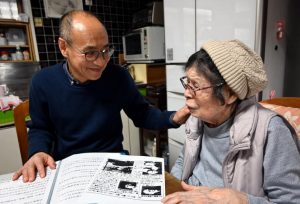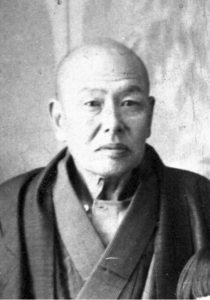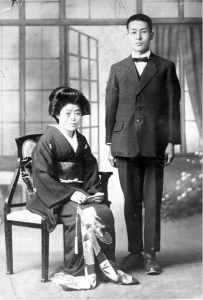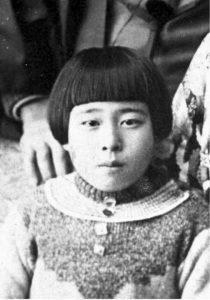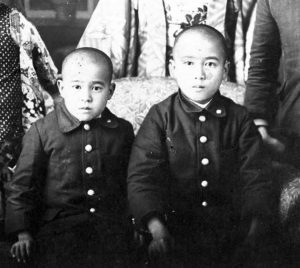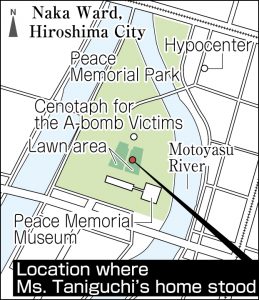In role as Family A-bomb Legacy Successor, Kyoto’s Toshifumi Taniguchi hopes to pass on experience of A-bomb survivor mother, who was orphaned after losing 6 family members
Apr. 8, 2024
Official appointment ceremony to be held April 23
by Kyoko Niiyama, Staff Writer
Her home had been located in what is now the lawn area of present-day Peace Memorial Park, in Hiroshima’s centrally located Naka Ward. Hisako Taniguchi (née Muraki), 89, a resident of the city’s Saeki Ward, lost six family members in the atomic bombing and lived as an orphan after the war. This month, Toshifumi, 62, Hisako’s oldest son who is a resident of Uji City in Kyoto Prefecture, is scheduled to begin work as a Hiroshima City-appointed Family A-bomb Legacy Successor, in the hopes of conveying the harsh life of his mother as her son. The family successors are A-bomb survivor family members, such as children or grandchildren, who can share with the public the A-bomb experiences of family members.
“I want to see them again,” Hisako said, holding small photographs of her deceased family members, her eyes filled with tears. She dabbed at her eyes as Toshifumi said, “Thank you for sharing your story with me.”
In the former Zaimoku-cho area of Hiroshima, Hisako lived together with five other family members — Shigetoshi, her grandfather, 77 at the time; Toshihiro, her father, 44; Tsune, her mother, 47; Kazuko, her older sister, 16; and Masayoshi, her older brother, 14. The family is said to have managed a seal shop, selling official seals to the prefectural and city government offices.
At that time, Hisako was in the fifth grade at Nakajima National School (present-day Nakajima Elementary School). She had been evacuated to the countryside outside of the city with a group of schoolchildren but, missing her family, she returned home at the end of July 1945. On August 5, her older brother, Ryohei (18 at the time), who worked at the Kure Naval Arsenal, was home on vacation. She still remembers the joyous family get-together that night.
On the morning of the next day, August 6, she was in her school auditorium. She heard the voice of someone call out, “I see a plane,” and was about to go into the schoolyard, when she experienced a bright flash of light.
After crawling out on her own power from under the collapsed school building, located about 1.1 kilometers from the hypocenter, she ran for her life. Sleeping in the open that night, she tried to head home the next morning but, she said, “The soles of my feet were so hot.” She found that the area surrounding the remnants of her home, about 330 meters from the hypocenter, had been burned to the ground. “There were people groaning in pain on Aioi Bridge and many bodies of the dead floating in Motoyasu River. It was hell on earth.”
The six people from her family who died that day are believed to have been either at home or at the site where they had been mobilized for work when the atomic bomb was dropped. Apart from what appeared to be bones she had retrieved from the ruins of her home, there was nothing left of her family, including their remains or any personal items. Photos of her family in the possession of her relatives in Kyushu and wooden Buddhist memorial tablets on which are handwritten their names were the entirety of any evidence that the six had existed in this world.
Having lost everything at the age of 11, Hisako was raised by her aunt after the war. She was 24 when she married Yukinobu, now 94, also an A-bomb survivor. The couple later had two children. She rarely spoke about her experiences in the atomic bombing with her own family.
Toshifumi said, “I used to think she should not be reminded of that time.” He had avoided discussing it with her, partly because he had been away from Hiroshima for a long time for college and work. Deep in his heart, however, he wanted to learn about what his mother had experienced. In 2020, he began to undergo training provided by the Hiroshima City government to become an A-bomb Legacy Successor, a program by which third-party people communicate the experiences and memories of A-bomb survivors on their behalf. Upon learning about the city’s new Family A-bomb Legacy Successor program, he began to have a change of heart. He confided to his mother about his belief that he had a role to play as a second-generation A-bomb survivor.
Traveling back and forth between Hiroshima and Kyoto, he would listen carefully to his mother’s stories, taking in everything, including her feelings that could not be expressed in words. When he handed over his completed successor manuscript to her, she expressed her pleasure. “Thank you for not forgetting about the six others,” she said.
A ceremony for the appointment of the Family A-bomb Legacy Successors is scheduled to take place on April 23. In addition to regular related activities at the Hiroshima Peace Memorial Museum and elsewhere, he hopes to communicate with students at elementary schools and junior high schools in Kyoto. “I’ll speak to children with the consciousness that I am speaking to them together with my mother.”
(Originally published on April 8, 2024)

